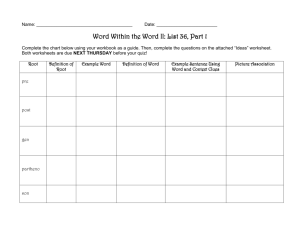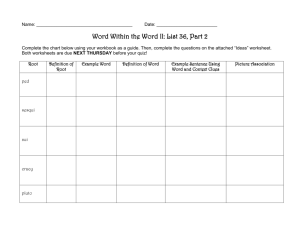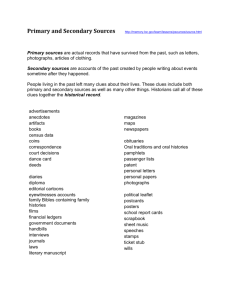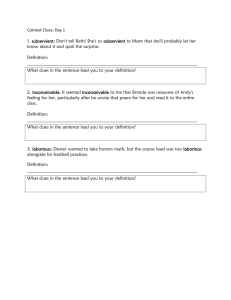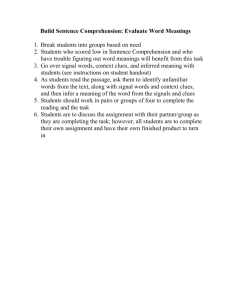Mock MCAS Interventions, CC1
advertisement
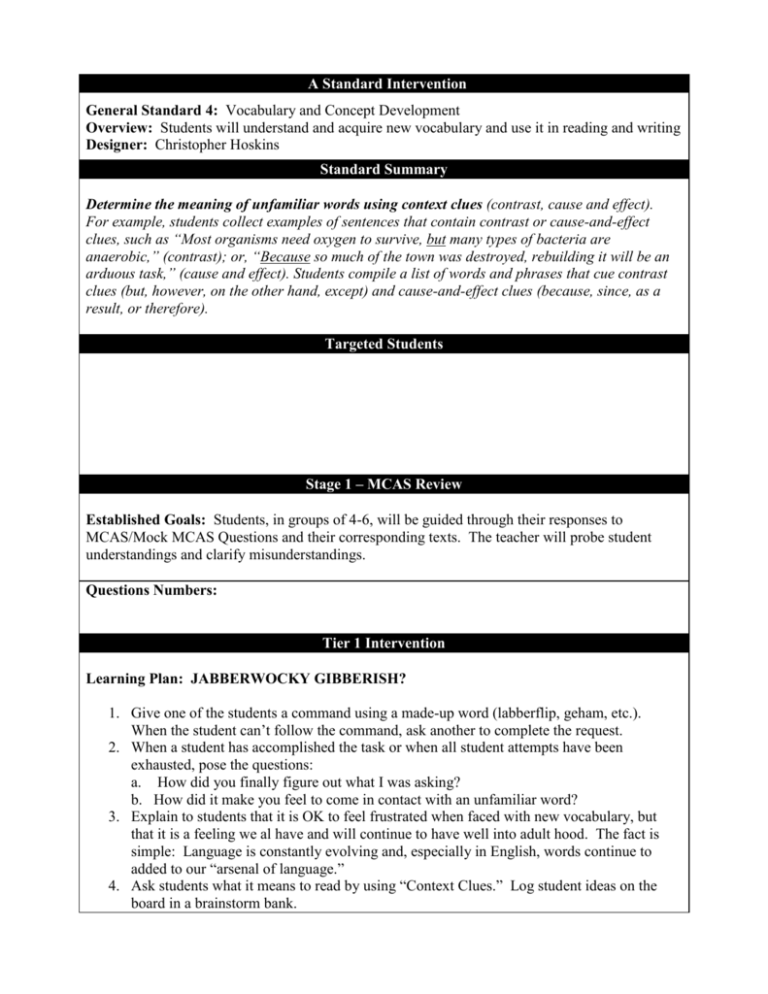
A Standard Intervention General Standard 4: Vocabulary and Concept Development Overview: Students will understand and acquire new vocabulary and use it in reading and writing Designer: Christopher Hoskins Standard Summary Determine the meaning of unfamiliar words using context clues (contrast, cause and effect). For example, students collect examples of sentences that contain contrast or cause-and-effect clues, such as “Most organisms need oxygen to survive, but many types of bacteria are anaerobic,” (contrast); or, “Because so much of the town was destroyed, rebuilding it will be an arduous task,” (cause and effect). Students compile a list of words and phrases that cue contrast clues (but, however, on the other hand, except) and cause-and-effect clues (because, since, as a result, or therefore). Targeted Students Stage 1 – MCAS Review Established Goals: Students, in groups of 4-6, will be guided through their responses to MCAS/Mock MCAS Questions and their corresponding texts. The teacher will probe student understandings and clarify misunderstandings. Questions Numbers: Tier 1 Intervention Learning Plan: JABBERWOCKY GIBBERISH? 1. Give one of the students a command using a made-up word (labberflip, geham, etc.). When the student can’t follow the command, ask another to complete the request. 2. When a student has accomplished the task or when all student attempts have been exhausted, pose the questions: a. How did you finally figure out what I was asking? b. How did it make you feel to come in contact with an unfamiliar word? 3. Explain to students that it is OK to feel frustrated when faced with new vocabulary, but that it is a feeling we al have and will continue to have well into adult hood. The fact is simple: Language is constantly evolving and, especially in English, words continue to added to our “arsenal of language.” 4. Ask students what it means to read by using “Context Clues.” Log student ideas on the board in a brainstorm bank. 5. Use student ideas to build a definition: Other words built into the sentences around the word that help you to understand the meaning of the new word. Provide students with the possible types of context clues: Definition, Synonym, Antonym, Example, Explanation. 6. Introduce students to Lewis’ Carroll’s “Jabberwocky,” a play built of nonsensical words that hold meaning because of the greater context and the words/phrases that surround them. 7. Ask students to silently read through the text the first time, circling words that are unfamiliar to them, then jotting these on the left side of their T-Charts. 8. When students have finished, read the text aloud for the students so that they get a feel for the sound of the piece. 9. Ask students to work in partners to discuss the meaning of the poem. Partnerships will develop a summary of the piece and log this on the top of their graphic organizer. 10. Ask partnerships to share their understandings in a teacher-guided, whole class discussion. 11. Ask students how they came to understand this meaning. When students have shared, point out that the context clues of the greater piece enabled them to overcome the nonsense words that are so rich within it. 12. Ask students to return to the nonsense words of their graphic organizer and, after having modeled the process with a nonsense word of your own, ask them to identify the context clues surrounding it, to identify the meaning of the word, then to use their dictionary/thesaurus to identify three synonyms for the nonsense word. 13. Summarize the lesson by making the point: Simply because a word is new to you, doesn’t make it complete nonsense! Good writers and good writing will provide you clues to uncover the mystery and crack the code! Use your context clues! Assessment: 1. Collected graphic organizers ill be collected and individually assessed. Struggling students will move to the Tier 2 Intervention. Good to Go! In Need of Tier 2 Intervention Tier 2 Intervention Learning Plan: BLACKOUT! 1. Ask students what is meant by the term “Background Knowledge.” Log student responses on the board in a Community Brainstorm Bank. Use this as a beginning for a formal definition: It is the brain's storehouse of information that helps us to make sense of new information. 2. Draw a line down the center of the board or a sheet of paper. Ask students to consider when background information is helpful. Log this onto the left-side. Ask student to consider when background information can be potentially hurtful and log this onto the right-hand side (consider stereotypes, vocabulary, etc.) 3. Explain to students that background information acts like a light switch: At times we want it “on” and it is helpful, while at other times, we it can get in the way and we want to turn it “off.” 4. Provide students with the example below: Mr. Jones and a battery of his coworkers stormed into the lunchroom, demanding more satisfying lunches for his students. 5. Ask students to identify the meaning of the word “battery” as it is used in the sentence. Log responses onto a brainstorm bank. When ideas have been exhausted, work through the suggestions, by first explaining that some work because the background switch was “on” while others represent the background switch in the “off” position. To help students see what definitions best work, guide them through the process of substitution (as described below) by starting with those definitions that need to be eliminated: Steps in the substitution strategy: Step 1: When you read a sentence that you have trouble understanding because of an unfamiliar word, reread the sentence and, using your context clues, substitute a word that you think makes sense in the sentence Step 2: Read on. If the word you substituted does not make sense in the context of the rest of the paragraph, try again! 6. Circle those definitions that work, cross out those that do not, and note that what got in he way for some student’s was too heavy a reliance on their background information and not enough on the text itself. Sometimes we just need a blackout! 7. Repeat steps 4-6 as necessary, providing new sentences each time, until you feel comfortable that students are able to undertake the substitution strategy on their own. Assessment: 1. Students will independently complete and submit “Context Clues” assignment. Based on performance, students will participate in individual interventions with the teacher Good to Go! One on One Needed JABBERWOCKY Lewis Carroll (from Through the Looking-Glass and What Alice Found There, 1872) `Twas brillig, and the slithy toves Did gyre and gimble in the wabe: All mimsy were the borogoves, And the mome raths outgrabe. "Beware the Jabberwock, my son! The jaws that bite, the claws that catch! Beware the Jubjub bird, and shun The frumious Bandersnatch!" He took his vorpal sword in hand: Long time the manxome foe he sought -So rested he by the Tumtum tree, And stood awhile in thought. And, as in uffish thought he stood, The Jabberwock, with eyes of flame, Came whiffling through the tulgey wood, And burbled as it came! One, two! One, two! And through and through The vorpal blade went snicker-snack! He left it dead, and with its head He went galumphing back. "And, has thou slain the Jabberwock? Come to my arms, my beamish boy! O frabjous day! Callooh! Callay!' He chortled in his joy. `Twas brillig, and the slithy toves Did gyre and gimble in the wabe; All mimsy were the borogoves, And the mome raths outgrabe.

